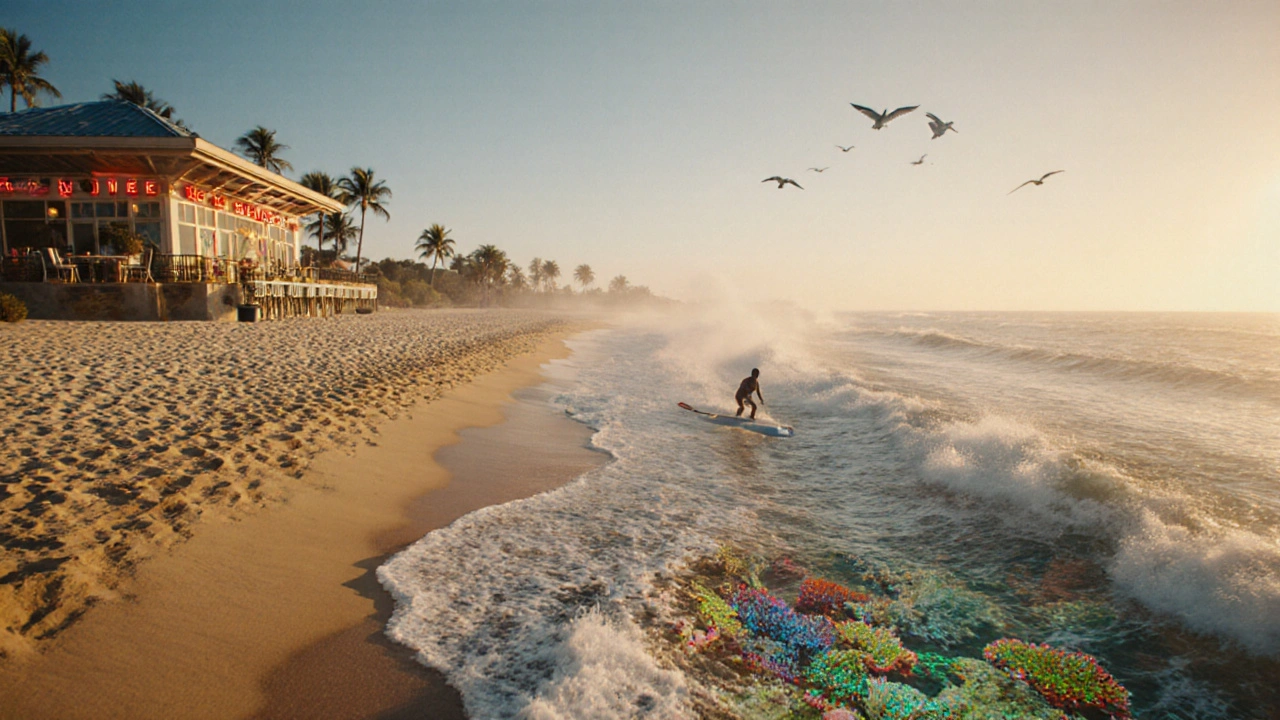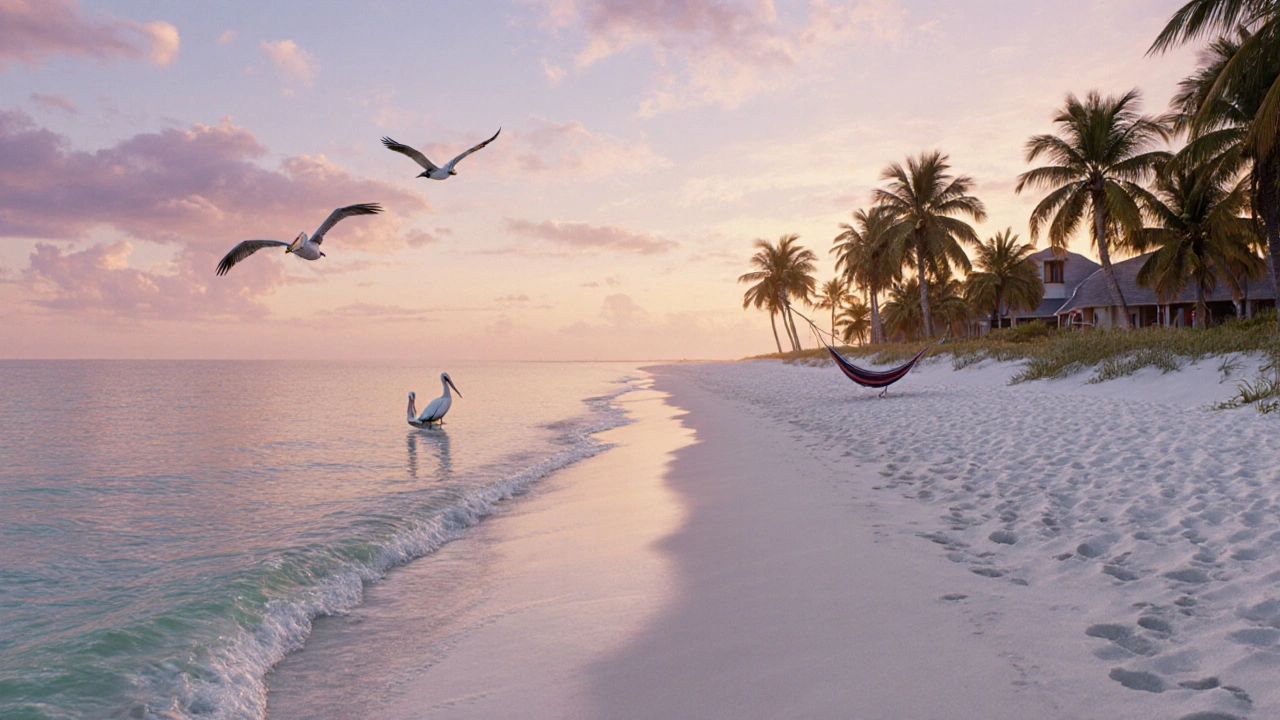Florida isn’t just a state-it’s two different worlds wrapped in sunshine. One side glows with soft, powdery white sand and calm turquoise waters. The other crashes with Atlantic swells, lively boardwalks, and vibrant coral reefs. So which side is prettiest? It depends on what kind of beauty you’re after. There’s no single answer, but there are clear differences that make one side better for your vibe.
The Gulf Coast: Soft Sands, Quiet Waters
The Gulf of Mexico side-stretching from Pensacola down to Naples-is where Florida slows down. The water isn’t deep blue like the Caribbean, but a pale, milky turquoise that looks like liquid glass. It’s shallow for miles, so wading out feels like walking on a giant swimming pool. The sand? Pure white, made from crushed quartz that doesn’t get hot underfoot. You can walk barefoot for a half-mile without stepping on a shell or pebble.
Destin and Clearwater are the big names here, but the real gems are the smaller towns. Siesta Key has been named one of the top beaches in the U.S. for over a decade-not because it’s crowded, but because the sand feels like powdered sugar. Panama City Beach is family-friendly, with calm waves perfect for kids. And don’t skip St. George Island. It’s only accessible by one road, has no chain hotels, and at sunset, the sky turns peach and lavender while pelicans glide over the water.
The Gulf side doesn’t have big waves. That’s not a flaw-it’s the point. This is where you come to read under an umbrella, nap in a hammock, or watch dolphins roll in the distance. The water stays warm well into fall. Even in November, you’ll find people swimming in 72°F water. The reefs are farther out, so snorkeling isn’t common here. But if you want peace, quiet, and water that looks like it’s been photoshopped, this is it.
The Atlantic Coast: Waves, Reefs, and Energy
Flip to the other side of the state, and everything changes. The Atlantic Coast-from Jacksonville down to Miami-has energy in its bones. The water is deeper, darker blue, and often choppy. Waves roll in with real force, making it a surfer’s dream. Cocoa Beach is where professional surfers train. Daytona Beach has the famous hard-packed sand where cars used to race on the shore. And Fort Lauderdale? It’s got yachts, beach clubs, and a nightlife that doesn’t quit.
This side is where you find Florida’s coral reefs. The only living coral barrier reef in the continental U.S. runs from Miami to the Dry Tortugas. Snorkelers and divers come here to see parrotfish, sea turtles, and even the occasional reef shark. Key Largo and Islamorada are the go-to spots for underwater exploration. You won’t find white sand here. The beaches are more golden, sometimes gritty, but they’re alive with activity.
The Atlantic side also has more hurricanes. It’s true. But that doesn’t mean it’s dangerous-it just means the landscape is wilder. Storms carve new inlets, reshape dunes, and stir up the ocean. That’s why the water here is clearer and richer in marine life. The sunsets aren’t as soft as on the Gulf, but the sunrises? Unbeatable. Watch the first light hit the waves from a beachfront café in Cocoa Beach, and you’ll understand why locals call this side the soul of Florida.
Central Florida: Not the Beach, But Still Beautiful
Don’t ignore the middle. While most people think of Orlando’s theme parks when they hear "Central Florida," there’s another side to it. The St. Johns River winds through lush green wetlands. You can kayak past alligators and herons without seeing another person. Lake Okeechobee is the largest freshwater lake in the state, and at dawn, mist rises off the water like smoke. The area around Titusville has rocket launches from Kennedy Space Center lighting up the night sky-something you won’t find anywhere else in the country.
Yes, it’s not a beach. But if you’re looking for natural beauty that’s quiet, wild, and uniquely Floridian, this is it. The air smells like pine and saltwater. The roads are lined with Spanish moss hanging from live oaks. You’ll see more birds than people. And if you’re lucky, you’ll catch a manatee floating lazily in a spring-fed river.

What’s the Real Winner?
Here’s the truth: neither side is "prettier." They’re just different. The Gulf Coast is like a spa day-gentle, soothing, perfect for unwinding. The Atlantic Coast is like a concert-vibrant, loud, full of movement. One gives you quiet sunsets. The other gives you sunrise surf sessions.
If you want to relax, bring a book, and feel like you’ve escaped the world, pick the Gulf. If you want to dive, surf, explore reefs, and end your night with live music on the beach, pick the Atlantic.
And if you’re really curious? Do both. Most locals do. They spend weekends on the Gulf in winter and head east in summer when the Atlantic is warmest. You don’t have to choose. Florida’s beauty isn’t about picking a side-it’s about experiencing both.
When to Go
Florida’s weather shifts fast. The Gulf side is most pleasant from late October through April. That’s when the humidity drops, the bugs vanish, and the water stays warm enough to swim. The Atlantic side peaks in spring (March-May) and early fall (September-October). Summer here is hot and humid, but the ocean breezes make it bearable.
Avoid July and August if you hate crowds. That’s when the whole country shows up. November is ideal-warm enough for the beach, cool enough to sleep without AC, and far enough from the holiday rush.

What to Pack
For the Gulf Coast: lightweight cover-ups, a wide-brimmed hat, and flip-flops. You won’t need water shoes-the sand is too soft. Bring a towel that dries fast. A good book. Maybe a portable speaker for low-volume music.
For the Atlantic Coast: water shoes (reefs and shells can be sharp), a rash guard if you’re surfing, reef-safe sunscreen, and a waterproof phone case. Snorkel gear is a must if you’re heading to the Keys. And don’t forget a hoodie-Atlantic nights get chilly, even in November.
Final Thought
People ask which side of Florida is prettiest like it’s a contest. But beauty isn’t about winning. It’s about matching the place to your mood. One side cradles you. The other wakes you up. Both are real. Both are unforgettable.
Is the Gulf Coast or Atlantic Coast better for families?
The Gulf Coast is generally better for families with young kids. The water is calmer, shallower, and safer for wading. Beaches like Clearwater and Siesta Key have gentle slopes, lifeguards on duty, and plenty of amenities like restrooms and picnic areas. The Atlantic Coast has stronger currents and bigger waves, which can be risky for small children unless you stick to protected areas like Cocoa Beach’s northern end.
Can you snorkel on the Gulf Coast?
You can, but it’s limited. The Gulf’s coral reefs are farther offshore and not as vibrant as those on the Atlantic side. Most snorkeling spots on the Gulf are near artificial reefs-like the ones off Clearwater or St. Pete Beach-but you won’t see the same diversity of fish or colorful coral. For serious snorkeling, head to the Florida Keys or Biscayne National Park on the Atlantic.
Which side has the best sunsets?
The Gulf Coast wins for sunsets. Because the sun sets over the water here, the sky reflects off the calm surface, creating long, soft gradients of pink, orange, and purple. Places like Clearwater Beach and Naples Pier are famous for sunset gatherings. The Atlantic side has more cloud cover and wind, which often breaks up the sky. Sunrises are better on the Atlantic, though.
Is one side more expensive than the other?
Generally, yes-the Atlantic Coast tends to be pricier, especially in Miami, Fort Lauderdale, and the Keys. Hotels, restaurants, and rentals there are geared toward tourists and nightlife. The Gulf Coast has more budget-friendly options, particularly in smaller towns like Anna Maria Island or St. George Island. But luxury resorts exist on both sides, so it depends on where you stay, not just which coast.
Are there fewer crowds on one side?
Yes, the Gulf Coast usually has fewer crowds, especially outside of spring break and holidays. Towns like Cedar Key, Apalachicola, and St. Vincent Island are quiet year-round. The Atlantic Coast, particularly from Daytona south to Miami, gets packed in winter and spring. But if you go to less-known spots like Sebastian Inlet or Flagler Beach, you’ll find peace even on the Atlantic side.
What to Do Next
If you’re planning a trip, start by asking yourself: Do I want to relax or explore? If you’re unsure, split your time. Spend three days on the Gulf, then drive to the Atlantic for three more. You’ll get both sides of Florida-and you’ll realize the real beauty isn’t in picking one. It’s in seeing both.

